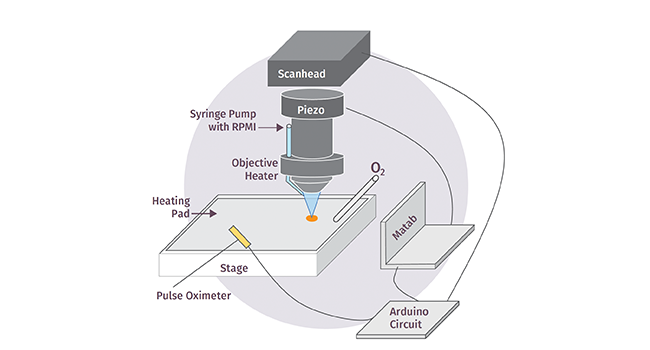When the first prototype designed to follow immune cells in the arteries of living mice failed, Sara McArdle, Ph.D., nabbed a handful of coffee stirrers at a nearby coffee shop and started tinkering. “Constructing with the little wooden sticks helped me think through the problem and figure out the solution,” says Dr. McArdle, a microscopy specialist in La Jolla Institute’s (LJI) imaging core.
Trained as a medical bioengineer, Dr. McArdle feels most at home at the intersection of biomedical research and technology. It satisfies her desire to make an impact on people’s lives while taking comfort in the predictability of engineering. “There aren’t biological laws in the way that there are mathematical laws or physical laws,” she says. “A computer does exactly what you tell it to and if something doesn’t work you told it the wrong thing. But it also means you can fix it.”
Cue the coffee stirrers. After rethinking her first attempt, Dr. McArdle, then a graduate student in the lab of LJI Professor Klaus Ley, M.D., ended up building a device that combined circuits and programming software to synchronize the image frequency of a high-tech microscope with a mouse’s heart beat.

“A big part of atherosclerosis research looks at blood flow and how it influences what’s going on in the blood vessel,” says Dr. McArdle. “The big complication is that some of the large arteries, the kind that are affected by atherosclerosis, move with every pulse, which makes it really hard to keep things in focus.” All of a sudden, Dr. McArdle’s cleverly designed contraption allowed scientists for the first time to catch a glimpse of immune cells weaving in and out of arterial plaques. “It was a really cool project that changed how we look at the role of the immune system in cardiovascular disease,” she says.
It also changed Dr. McArdle’s career trajectory. “I realized that I didn’t want to follow the standard academic track,” she says. “I love being in the lab and developing new tools.” Since Dr. McArdle already spent most of her time in the imaging core, it was only natural that she would move there permanently.
Today, she works as a microscopy specialist in the imaging core and regularly does deep dives into the newest imaging technologies to push the limits of what scientists can see. “Once you realize how major things can change, it changes the way you think,” Dr. McArdle says. “Suddenly, you don’t just think about how to adjust the project to fit the resources. Instead you think about the resources we need to fit the project.” In her spare time, Dr. McArdle likes to bake and is widely known for her deliciously chewy chocolate chip cookies. Whether she likes to tinker with cookie recipes as well, she wouldn’t say.


